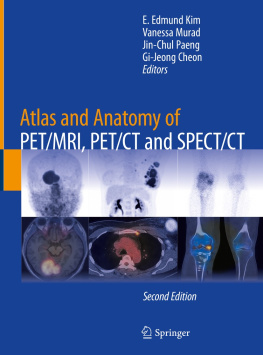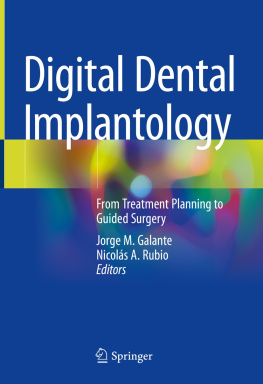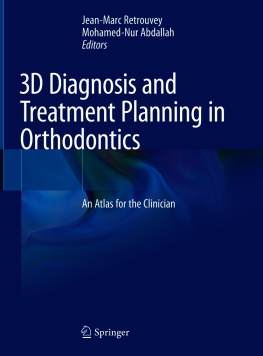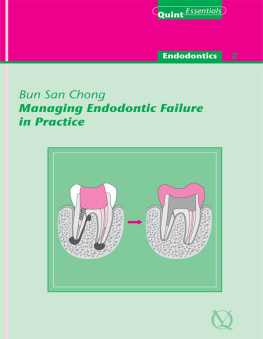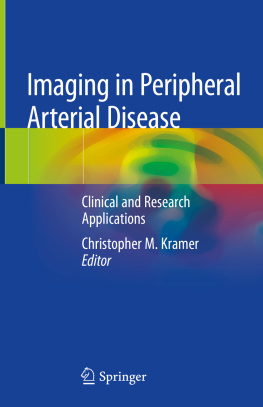Library of Congress Cataloging-in-Publication Data
Miles, Dale A.
Atlas of cone beam imaging for dental applications / Dale A. Miles. 2nd ed.
p. ; cm.
Rev. ed. of: Color atlas of cone beam volumetric imaging for dental applications / Dale A. Miles. c2008.
Includes bibliographical references and index.
ISBN 978-0-86715-565-5 (hardcover)
eBook ISBN 978-0-86715-592-1
I. Miles, Dale A. Color atlas of cone beam volumetric imaging for dental applications. II. Title.
[DNLM: 1. Stomatognathic Diseases--radiography--Atlases. 2. Cone-Beam Computed Tomography--methods--Atlases. WN 17]
616.075722--dc23
2012036568
2013 Quintessence Publishing Co, Inc
Quintessence Publishing Co, Inc
4350 Chandler Drive
Hanover Park, IL 60133
www.quintpub.com
5 4 3 2 1
All rights reserved. This book or any part thereof may not be reproduced, stored in a retrieval system, or transmitted in any form or by any means, electronic, mechanical, photocopying, or otherwise, without prior written permission of the publisher.
Editor: Bryn Grisham
Design: Ted Pereda
Production: Angelina Sanchez
Preface to the Second Edition
I am overwhelmed and somewhat humbled by the unexpected success of the first edition of this atlas. I am also deeply grateful to the many colleagues who have approached me at seminars to tell me that they keep this book beside them when they are examining their cone beam volumes as well as to the many others who have asked me to sign their copy of the first edition. Obviously, the book has made an impact in this exciting new era of oral and maxillofacial radiology.
In this updated second edition, I have used the term cone beam computed tomography (CBCT) instead of cone beam volumetric imaging (CBVI). I still believe that the more correct term for this modality is volumetric imaging. However, as most of my radiology colleagues have pointed out, the term CBCT is ensconced in the dental and medical literature, so I have decided, somewhat reluctantly, to adopt the term myself. In addition to the minor title change, I have added new cases to most chapters, developed a new section to address anatomy in the small volume, and added three new chapters to discuss applications for CBCT in endodontics, the risks and liabilities of CBCT, and selected cases from my radiology practice. I believe that these additions and updates have strengthened the book and made it even more useful.
I am smart enough to know my limitations, and in this edition, I have invited my first contributor, Dr Thomas McClammy*, a great endodontist and a great friend. He has written chapter 16 about the use of CBCT in the specialty of endodontics. As an early adopter, Dr McClammy did his due diligence, agonized over the decision to purchase a CBCT machine, and then plunged in. He has been like a kid in the proverbial candy store, and his enthusiasm about this modality comes through as he explains its incredible utility in his practice of endodontics.
Finally, some readers may question a radiologist attempting to address liability issues arising from the use of CBCT. However, I feel very strongly that some colleagues are setting themselves up for legal action by persisting in looking at the CBCT volumes only to determine a suitable implant site, and by neglecting the examination of the rest of the data or its referral to a specialist. This is the professions standard of care when a task or diagnosis is beyond our capability. Most of what I state in chapter 17 is common sense. Nevertheless, I am taking this risk myself by addressing this concern directly. I do it for my own peace of mind and to educate my colleagues.
I know the reader of this second edition will see these developments in the books content as both necessary and exciting. Enjoy, and thanks again for the support.
* Thomas V. McClammy, DMD, MS
Private Practice
Scottsdale, Arizona
Preface to the First Edition
Like any innovation in the dental profession, the availability of cone beam volumetric imaging (CBVI) has preceded the understanding of its use. It happened with panoramic imaging as it did with digital radiographic imaging. The cone beam images in this atlas will educate dental professionals on how to use CBVI technology to better visualize the diseases and disorders that they encounter with their patients.
One aim of this atlas is to refresh the readers memory of anatomy. As dentists we never worked in the axial plane of section after our anatomy training; we have lived our lives in a world of plain films or digital images, all in the format of 2D grayscale panoramic, intraoral, or lateral cephalometric images. CBVI allows us to visualize patient anatomy and pathology like never before. CBVI helps to reveal bony changes caused by pathology. In addition, the level of anatomic detail in the 3D image sets means that clinicians placing implants no longer have to experience anxiety about whether they are placed correctly. CBVI allows us to determine the precise location of the inferior alveolar nerve in relation to impacted mandibular third molars, which improves preoperative planning and reduces patient morbidity as well as our liability. At last, we can see out patients problems in a whole new mannerin 3D and color. I hope this book will help you understand how CBVI can improve your clinical experiences and the management of your patients treatment.
Acknowledgments
I am deeply appreciative to CyberMed USA and CyberMed International for allowing me to continue to test their software product and to use it in my practice. I happen to think that it is the premier software for examining cone beam computed tomography image data. Mr Eusoon Han and the marketing team at CyberMed USA work tirelessly to support the product and have helped me understand the incredible tools within the software. Thanks to all. Thanks once more to Prof C. Young Kim, the CEO of CyberMed International for your product, your confidence, and your friendship. This book would not be possible without your product and support.
A big thank you to Mr William Hartman of Quintessence for going the extra mile with my requests, and to Ms Lisa Bywaters and Ms Bryn Grisham for their editorial support.
Finally, love and special thanks to my wife, Kathryn, for her continued support, love, confidence, sacrifice, and patience.
CBCT in Clinical Practice
Nothing has captured the dental professions imagination in the past few years like the introduction of cone beam volumetric imaging (CBVI), which is now referred to by most clinicians and even in the literature as cone beam computed tomography (CBCT). I too now refer to the data volumes I receive from clients as CBCT volumes, despite my opinion that CBCT images bear no resemblance to traditional medical computed tomography (CT) scans except in the display of the final product.
The process of image acquisition for CBCT machines is unlike traditional medical CT scanners in that the patient is not usually supine, the image gathered is in a voxel (volume element) format, the x-ray dose absorbed by the patient is substantially lower, appointment availability is much easier, and it is less expensive. In short, although this imaging modality produces signicant data volumes like medical CT, it is different and vastly superior to traditional CT data for specic dental applications.
Dentists and dental specialists continue to be amazed at the incredibly precise and profound information produced by CBCT scans, and they are realizing that the data they receive will influence their treatment decisions like no other imaging modality used in the profession in the past 100 years. CBCT makes clinical decision making easier and more precise, patient treatment decisions more accurate, and visualization of the x-ray data more meaningful. Dentistry is moving away from radiographic interpretation and into disease visualization, and it could not have come at a better time.
Next page



